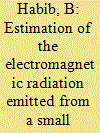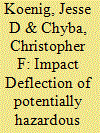|
|
|
Sort Order |
|
|
|
Items / Page
|
|
|
|
|
|
|
| Srl | Item |
| 1 |
ID:
077378


|
|
|
|
|
| Publication |
2007.
|
| Summary/Abstract |
Centrifuges used to enrich uranium utilize an electric motor to spin the rotors to high speeds. The current flowing in these motors emits electromagnetic radiation. This article presents a model that estimates the strength of the radiation as a function of distance from the centrifuge plant. It discusses the dependence of the radiative power on the size of the plant, the noise sources at the frequencies at which the motors operate, and means of detecting the signal from a centrifuge enrichment facility. According to the findings, a plant running 1,000 P-2 type centrifuges emits electromagnetic radiation that should be detectable in a 0.5-3 kilometer range in the absence of shielding.
|
|
|
|
|
|
|
|
|
|
|
|
|
|
|
|
| 2 |
ID:
077380


|
|
|
|
|
| Publication |
2007.
|
| Summary/Abstract |
Nuclear explosions, and a wide variety of technologies not yet realized, have been proposed to deflect asteroids away from collision with Earth. In contrast, this article presents realistic models for simple kinetic energy impact deflection, using the actual orbital elements of 795 catalogued Potentially Hazardous Asteroids, and impactor masses launched to intercept trajectories by Atlas V HLV rockets or equivalent. The authors take asteroid diameter, density, cratering characteristics, and Earth-collision lead time as parameters whose influence is to be investigated. Assuming asteroids of rocklike density, the article finds deflection off of Earth-collision to be achievable given 5-year lead time with a single kinetic energy intercept for 100% of 250 m diameter PHAs, 20-year lead with a single intercept for 93% of 500 m PHAs, 20-year lead with 5 and 10 intercepts, respectively, for 55% and 94% of 1 km PHAs, or 100-year lead with 1 and 2 intercepts, respectively, for 55% and 94% of 1 km PHAs. Considering likely future lead times for Near-Earth Objects, simple impact deflection using current launch vehicles is therefore a viable strategy for up to kilometer-diameter asteroids. This method has important advantages over other proposals: it requires no new technologies, would not require development or testing of nuclear warheads, and would likely be the least costly, least risky, and fastest to effect
|
|
|
|
|
|
|
|
|
|
|
|
|
|
|
|
| 3 |
ID:
077377


|
|
|
|
|
| Publication |
2007.
|
| Summary/Abstract |
This paper analyzes the maneuverability, capabilities, and survivability of Chinese DF-31 mobile missiles and the ability of a proposed U.S. Space Radar system to persistently track them. The author posits possible defense strategies for the Chinese military and concludes that the survivability of the mobile DF-31's is not guaranteed during a nuclear attack given the huge U.S. strategic arsenal, but also questions the ability of the proposed U.S. Space Radar system to persistently track the DF-31's if the Chinese military engages in relatively simple countermeasures. Neither China nor the United States can be completely confident of a strategic advantage. The two countries need strategic dialogues to improve relations on this topic.
|
|
|
|
|
|
|
|
|
|
|
|
|
|
|
|
| 4 |
ID:
077379


|
|
|
|
|
| Publication |
2007.
|
| Summary/Abstract |
The problem of detecting a nuclear weapon smuggled in an ocean-going cargo container has not been solved, and the detonation of such a device in a large city could produce casualties and property damage exceeding those of September 11, 2001 by orders of magnitude. Any means of detecting such threats must be fast and cheap enough to screen the millions of containers shipped each year, and must be capable of distinguishing a threatening quantity of fissionable material from the complex loading of masses of innocent material found in many containers. Here we show that radiography with energetic X-rays produced by a 10 MeV electron accelerator, taking advantage of the high density and specific atomic properties of fissionable material, may be a practical solution
|
|
|
|
|
|
|
|
|
|
|
|
|
|
|
|
|
|
|
|
|